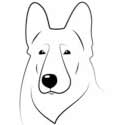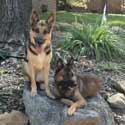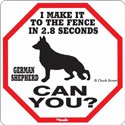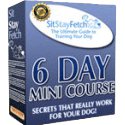I Found a Dog Lump
Finding a dog lump is not a rare occurrence.
Dogs may develop papules (small lumps) or nodules (large lumps) on their skin. They are fairly common, especially in older dogs. The lump may be within the skin, in the tissues under the skin or attached to the skin and the underlying tissues.
Help! My Dog Has a Lump!
A dog skin lump may immediately trigger the thought of cancer. But, there are many causes of dog lumps. The growth may be:
- abscess
- cyst (sebaceous cysts are comon)
- hematoma (blood filled mass)
- histiocytoma (bright red lump)
- lipoma (benign accumulation of fat)
- reaction to an allergen (hives)
- tumor (malignant or benign)
While there may be a number of possibilities, all lumps should be evaluated to ensure that they are not malignant.
Lump on Dog - What to Watch For
Call your vet immediately if you notice any new dog lump, especially those that are:
- attached to tissues under the skin
- bleeding
- growing rapidly
- irregular in shape
- painful
- ulcerated
- warm
Signs such as these indicate veterinary attention. Be prepared, since your vet will ask you several questions such as:
- How long has the lump been there?
- Has it become smaller or larger or changed in appearance? If so, how fast is it changing?
- Does it feel as if it is attached to the underlying skin?
- Has your dog had any recent injections or injuries?
- Is there only one lump?
- Are there any changes in your dog's behavior (eating less, weight loss, diarrhea, lethargy or vomiting)?
Your vet may aspirate the lump with a needle to collect cells for testing, perform a biopsy of part of the lump or the entire mass, or collect fluid from ulcerative lumps for further inspection. If bacteria or fungi are suspected, a piece of the tissue may be submitted for culture.
Types of Dog Lumps
Malignant Tumors
Malignant Tumors are collections of quickly growing, abnormal cancerous cells. They can endanger your dog's health by invading nearby tissues or spreading (metastasizing) to other parts of the body. There are many types of malignant tumors, but the most common are:
- Mast cell tumors. Composed of large numbers of mast cells - a type of cell normally found within the skin.
- Melanomas. These may be malignant or benign. Melanomas are tumors of the cell which provides skin pigment and are usually black in color. They can be very aggressive when located on the foot or mouth.
- Fibrosarcomas. This type of tumor is made up of cells that compose the connective tissue under the skin. They are destructive locally but rarely metastasize.
- Squamous cell carcinomas. These are malignant skin cell tumors that are usually located on lighter colored skin. They also are destructive in the local area and do not normally metastasize.
Benign Tumors
Benign tumors do not spread or invade other tissues. The require removal when they grow in areas where they may press upon an organ in a confined area (such as against the brain) or if they become damaged and inhibit other tissues. Common benign tumors are:
- Abscess. This is a collection of white blood cells that has been stimulated by an infection (bacteria or fungus).
- Cyst. A cyst will occur as a result of a skin gland abnormality. It is a collection of fluid or cell debris under the skin.
- Hematoma. A hematoma is a blood filled area under the skin that is usually caused by trauma or blood clot defect.
- Histiocytoma. This is a round cell tumor that appears as a bright red hairless lump on dog that will normally spontaneously regress without treatment.
- Hive. When an allergic reaction occurs, some cells will release chemicals that can swell and cause redness in the skin.
- Lipoma. This is a collection of fat cells found under the skin. They only become issues if they become very large and/or inhibit the normal movement of your dog.
- Perianal adenoma. This is found in the skin by the anus. It is more common in unneutered males. Malignant perianal adenocarcinomas are rare.
Treatment of a Dog Lump
The treatment for lumps on dogs will vary depending on the diagnosis.
Malignant tumors are usually surgically removed. Your vet may recommend chemotherapy or radiation, or if you see a holistic vet, a less traumatic treatment will normally be suggested.

Benign tumors are normally left alone unless they impede your dog's quality of life. If they bother you or your dog, you can try an herbal treatment such as
PetAlive Skin and Coat Tonic
.
It contains a variety of specially selected herbs, nutrients and biochemic tissue salts known to support the skin and coat.
Abscesses are normally cut open, cleaned and flushed. Afterwards, a regiment of antibiotics may be suggested.
Cysts can be opened and drained, but can be left alone unless they bother the dog (or the owner).
Hematomas not caused by trauma are treated by eliminating the underlying cause. Traumatic hematomas normally resolve themselves.
Hives caused by an allergic reaction are treated with anti-inflammatories.
Have a question about a dog lump?
You can easily get an answer from a vet online. Your answer is normally answered within a few hours and may save you a trip to the vet.
Life After Finding a Dog Lump
Finding a dog lump can be alarming. Have your vet check it out as soon as possible as you may be worrying about nothing. I found a lump on my Schatzi which thankfully turned out to be a sebaceous cyst.
What is a Sebaceous Cyst on my Dog?
This type of dog lump is nothing to worry about. It is primarily a cosmetic issue which can be compared to a pimple. They form when oil (sebum) accumulates in the hair follicle and forms a nodule under the skin. Regular dog grooming of your German Shepherd can help keep them from forming.






